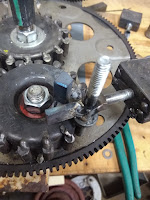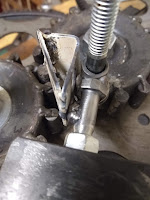Page 18, Little Red Wagon & Modifications Made

April 30, 2020 I decided to put the whole unit on a small (rather wobbly) little red wagon to see if it would pull it around or at least if it would make it easier to push it up an incline. The wagon is far too wobbly to be used effectively but it did push it around my shop floor. I also see the absolute necessity of making the sun gear timing adjustment lock securely. As I was testing, one of them suddenly drifted right, to the point where it tried to tip the red wagon over. It was time to tear it down and rebuild the gear adjustment locks…And so I did... Here is where I ended up. I have realized that the only "good" video I have put here is of the first functional demo unit. Here is a video of the it with all of the latest modifications (listed below). I did not have it on wheels in this video, it is very difficult to keep it on the bench if there is anything under it that it will roll on. Modifications Made: Switched wires on motor




